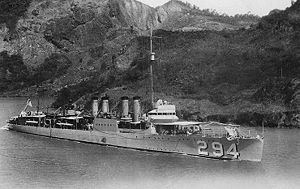Laid down 11 September 1919 Decommissioned 1 May 1930 Construction started 11 September 1919 Length 96 m | Commissioned 23 March 1920 Struck 22 October 1930 Launched 18 December 1919 Draft 3.12 m | |
 | ||
Namesake Charles Lawrence Ausburne Cost $1,217,839 (hull and machinery) | ||
USS Charles Ausburn (DD-294) was a Clemson-class destroyer built for the United States Navy during World War I.
Contents
Description
The Clemson class was a repeat of the preceding Wickes class although more fuel capacity was added. The ships displaced 1,290 long tons (1,310 t) at standard load and 1,389 long tons (1,411 t) at deep load. They had an overall length of 314 feet 4 inches (95.8 m), a beam of 30 feet 11 inches (9.4 m) and a draught of 10 feet 3 inches (3.1 m). They had a crew of 6 officers and 108 enlisted men.
Performance differed radically between the ships of the class, often due to poor workmanship. The Clemson class was powered by two steam turbines, each driving one propeller shaft, using steam provided by four water-tube boilers. The turbines were designed to produce a total of 27,000 shaft horsepower (20,000 kW) intended to reach a speed of 35 knots (65 km/h; 40 mph). The ships carried a maximum of 371 long tons (377 t) of fuel oil which was intended gave them a range of 2,500 nautical miles (4,600 km; 2,900 mi) at 20 knots (37 km/h; 23 mph).
The ships were armed with four 4-inch (102 mm) guns in single mounts and were fitted with two 1-pdr (28 mm) guns for anti-aircraft defense. In many ships a shortage of 1-pounders caused them to be replaced by 3-inch (76 mm) guns. Their primary weapon, though, was their torpedo battery of a dozen 21-inch (530 mm) torpedo tubes in four triple mounts. They also carried a pair of depth charge rails. A "Y-gun" depth charge thrower was added to many ships.
Construction and career
Charles Ausburn, named for Charles Lawrence Ausburne, was launched 18 December 1919 by Bethlehem Shipbuilding Corporation, Squantum, Massachusetts; sponsored by Mrs. D. K. Ausburn; and commissioned 23 March 1920, Lieutenant M. W. Hutchinson, Jr., in command. Assigned to the Atlantic Fleet, Charles Ausburn operated from Charleston, South Carolina, Norfolk, Virginia and Newport, Rhode Island along the Atlantic coast and in the Caribbean through 1924, serving with a reduced complement from October 1920 to May 1922. During those years, as she participated in fleet exercises and training maneuvers, she aided in the development and application of new ideas in naval warfare. In the fall of 1923, Charles Ausburn was equipped to carry a seaplane, with which she performed experiments in the rapidly developing field of naval aviation.
In late summer of 1924, Charles Ausburn cruised to northern latitudes to provide plane guard service in the round-the-world flight of Army aircraft, maintaining stations off Greenland and Newfoundland. On 18 June 1925, she sailed from Boston for a year of duty off Europe and in the Mediterranean, visiting at a large number of ports before her return to New York 11 July 1926. She continued her operations with the fleet, often providing facilities for the training of reservists, until 1 May 1930, when she was decommissioned at Philadelphia. There she was sold 17 January 1931.
